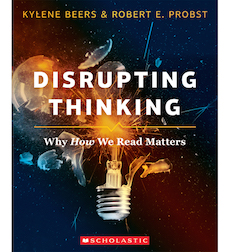Disrupting Thinking: Why How We Read Matters
Disrupting Thinking: Why How We Read Matters
By Kylene Beers and Robert E. Probst
(Scholastic, 2017 – Learn more)

Having discovered Kylene Beers several years ago, I knew that this book, Disrupting Thinking: Why How We Read Matters by Beers and Robert E. Probst, would resonate deeply with how I want to teach. How right I was.
When Kids Can’t Read/What Teachers Can Do (Beers) was a book that greatly reframed my classroom. When the Notice and Note (Beers and Probst) texts came out, those too strengthened my teaching and pool of strategies that I use to generate reading excitement in my teaching.

Too often, we ask our students to simply respond to questions that have answers that can be found in the text. Instead, we need to be asking them how the text impacts them and how they respond emotionally and intellectually and thus take responsibility for their own thinking.
It is this philosophy that drives Disrupting Thinking. Divided into three sections, each focuses on a different aspect of what teachers need to know to create responsive and responsible readers.
“The Readers We Want”
The readers we desire in our classrooms are those who will become our future leaders. In our current society, these students need to be able to raise questions and be flexible thinkers. Beers and Probst describe students who “learn to think creatively, critically, collaboratively, and compassionately” (22). They argue that students must change the way they think as they read and that conversation is key to this change.
As teachers, we find this a difficult mindset as we often expect our students to extract knowledge from the text and not respond to it. Responsiveness can be difficult to assess, but the authors argue that “responsiveness is critical for understanding” (29).
I know that my classroom is more alive when my students talk about personal responses and emotional connections than it is when they are tasked with finding two pieces of evidence to support a basic question. As the students become more responsive, this brings a responsibility to the text, and the hope is they also become more compassionate in the process.
“The Framework We Use”
The basic framework introduced to encourage the change in thinking is “Book, Head, Heart” (BHH). Having read and used the Notice and Note strategies, I see how seamlessly the two fit together. Numerous examples in the text from different grades show this BHH framework in action and demonstrate how it helps the students get into the book they are reading
This framework encourages the students to read beyond the words on the page and is something that can be used when talking about books, writing about books, and planning for using books.
It is a framework that can be used to remind us that “we read to do more than learn from the text; we read to do more than enjoy the text. We read to learn more about ourselves. We read to become more than we knew we wanted to be” (71). I see this helping the students make those textual connections that so often are left behind in the quest to better test scores.
“The Changes We Must Embrace”
The focus of this section is on disrupting our teacher thinking about reading and disrupting our students’ thinking about reading as well. This is about pushing our teaching from best practice to next practice and not just sustaining but also improving and innovating that teaching.
The authors argue teachers need to be willing to end a best practice to replace it with something more innovative – a next practice. As teachers, this is difficult as we are pushed to stick to proven practice backed by research to help improve test scores. Beers and Probst discuss, however, that innovation is what helps us thrive.
To me, this seems to tie in to a growth mindset philosophy. In order to be innovative teachers, we have to be willing to try things that might end in failure and accept that our students will still grow in the process.
We need to be willing to really focus on two questions Beers and Probst ask multiple times. “What needs to change?” and “What assumptions make that change hard?” The authors suggest that in order to really get our students reading, understanding, and enjoying, those students need to have choice in relevant reading, focused sustained reading, and time to talk about the reading.
Teachers need to be able and willing to disrupt the current thinking about what really needs to occur with reading practices in the classroom and to make the changes that will help our students become more responsive and responsible readers.
Final Thoughts
I appreciate this book because it is a fabulous reminder that our students need more than test preparation. They need teachers to be their guides to finding intrinsic motivation to read – motivation to do more than simply find answers to questions at the end of a chapter. Beers and Probst provide suggestions to do this that ultimately will lead to better comprehension and more overall knowledge, and will help to create the kind of thinkers that our society needs.
Read an excerpt from Disrupting Thinking here at MiddleWeb
Lisa Belcher is a 25 year veteran ELA teacher at Oak Hill Junior High School in Converse, Indiana. Currently, her teaching duties include seventh grade regular and advanced literature. She is also the advisor for the junior high honor society and the yearbook. She enjoys the global connections that the Internet and social media have provided to the teaching community. Her favorite units to teach are poetry and one that has the Iditarod as its focus.





































Lisa, thank you for this review. I will definitely put this book on my “To Read” list. I, too, met Beers several years ago. Her workshops at English conferences were always packed!